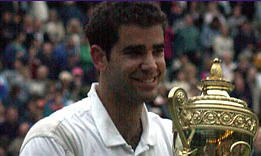
I always ask my first-time students a few questions to test their tennis IQ and to get to know them better. My first question is what sparked their interest in tennis....? If the answer is 'my mom's making me do it, I know I have an uphill battle on my hands...! But I rarely hear that response. I just like to know what's behind someone's motivation. It helps me coach them better. My motivation to play tennis when I started at the age of 12 was because I had a crush on a cute 13 year old girl who played...! And there's nothing wrong with that, because I think I turned out OK. But anyway, before I digress from here, let me get back to my topic of the day.
Another question I always ask is for them to name a pro player they may have seen on TV or read about, or perhaps someone they identify with.
I advocate watching every pro tennis match you can. Never miss an opportunity because that's like getting a free lesson.
Eventually, I want my students to have a role model. Someone who they might want to emulate because of outstanding shot, or temperament. This role model doesn't necessarily have to be a turing pro. It can be a coach, another peer, really it can be anybody. and it's ok to have more than one role model for different shots.
My role models were players who were a little shorter. I stand 5 feet 5 inches with only one pair of socks on, so I looked for successful players who border="0" />were the same stature as myself. I'll list some of my childhood role models and I know that these names won't mean a thing to many of you. You are probably either too young to have heard of them or you just didn't

grow up in the Bay City area like I did. I had many role models. On the professional side my all-time favorite player and role model was Bjorn Borg. I loved his temperament. He was quiet and stoic. He never showed emotion. He was one of the coolest players under pressure that I've ever seen. Another Pro player I admired was Harold Soloman. He was my height and had very steady ground strokes. Good temperament, too.
Then I had two local heroes. Kurt Zeller was one of the best players in Bay City when I was growing up. He was very steady and had a great slice backhand. He was a very smooth player and I've always tried to copy his game style. Another player I admired was a man named Michael Hansen. He was from Bay City and played college tennis for Houston Baptist University. He had a great serve and was pretty good at the net, too. Both these men would hit with me from time to time and they were a great inspiration to me growing up. I learned a lot just by watching, listening, and hanging out with them.
So, if you don't have a role model, get one. Have more than one. Have one for each different stroke if you want to. And look for local role models as well as pros on the world tour. This will help you improve your game in a hurry.
Thanks for reading my weekly tip. I welcome your comments and questions. Post one right here or email me at coachsam@sbcglobal.net
See you next time...!
Coach Sam
